Financial Analysis and Management of Resources and Decisions Report
VerifiedAdded on 2021/01/22
|20
|4063
|29
Report
AI Summary
This report provides a comprehensive analysis of managing financial resources and decisions, focusing on key financial concepts and techniques. It begins with an overview of the London Stock Exchange (LSE), discussing the advantages and disadvantages of listing, and exploring different methods for obtaining a listing and raising capital. The report then delves into specific financial calculations, including the cost of capital (ordinary shares, preference shares, and debentures) and the weighted average cost of capital (WACC). It emphasizes the importance of financial planning and analyzes the informational needs of different management levels within an organization. The report also examines the impact of finance on financial statements, presenting various financial ratios and investment appraisal techniques to assess the financial performance of a company. Furthermore, the report includes a production budget, a budgeted profit and loss account, and a discussion on the level of sales required to generate profits. Finally, the report concludes with an examination of main financial statements, income statement formats, and financial ratio analysis, providing a complete overview of financial management principles and practices.
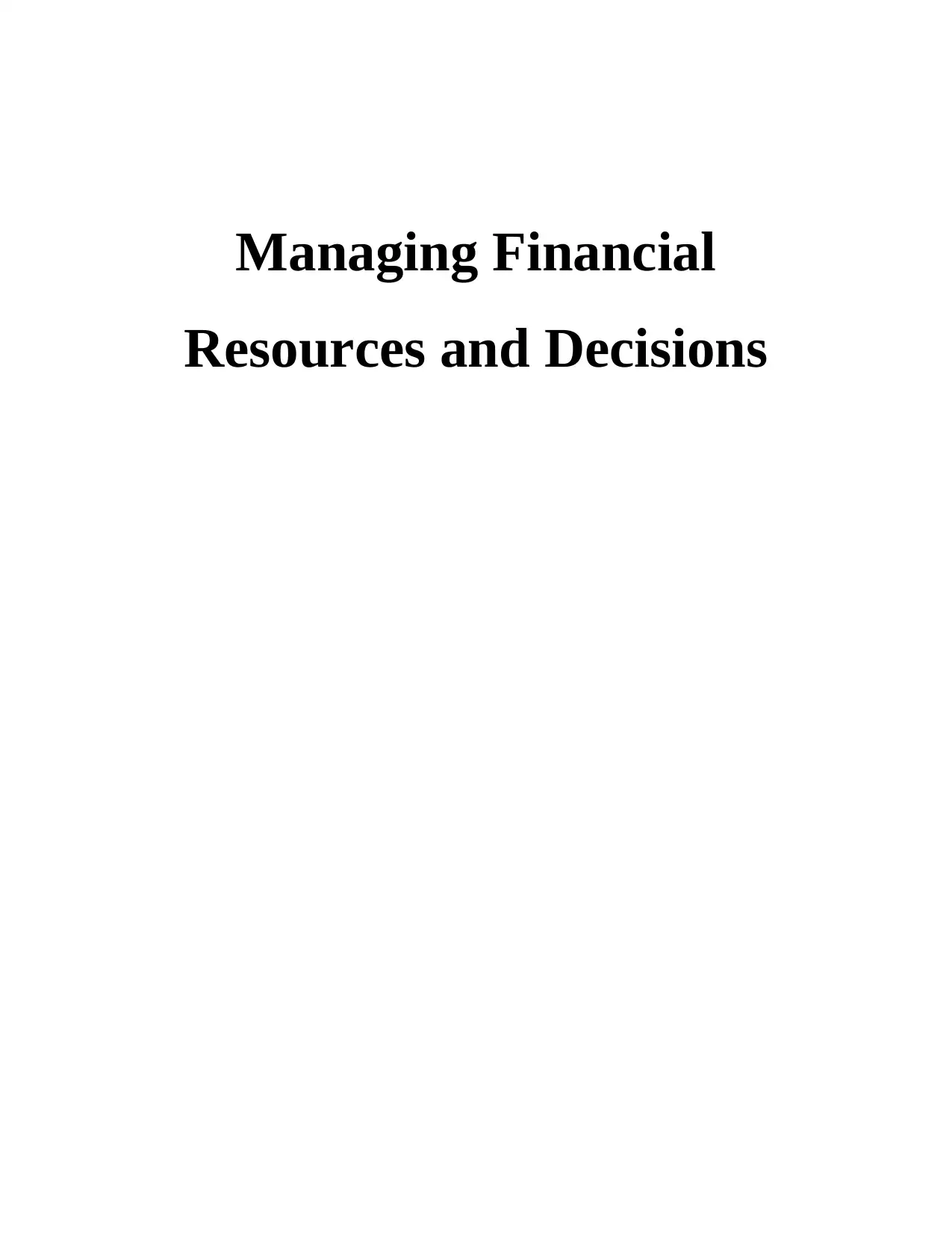
Managing Financial
Resources and Decisions
Resources and Decisions
Paraphrase This Document
Need a fresh take? Get an instant paraphrase of this document with our AI Paraphraser
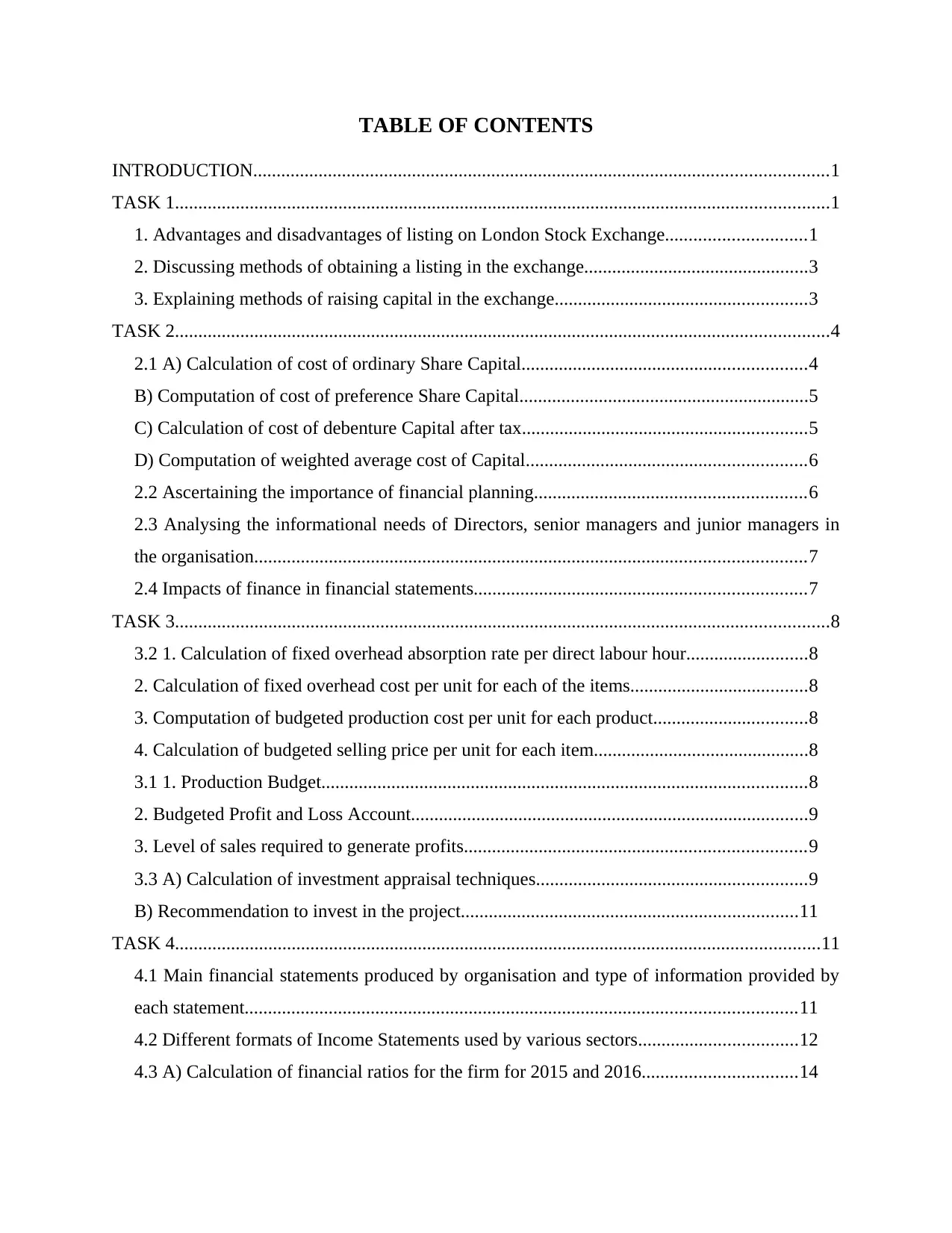
TABLE OF CONTENTS
INTRODUCTION...........................................................................................................................1
TASK 1............................................................................................................................................1
1. Advantages and disadvantages of listing on London Stock Exchange..............................1
2. Discussing methods of obtaining a listing in the exchange................................................3
3. Explaining methods of raising capital in the exchange......................................................3
TASK 2............................................................................................................................................4
2.1 A) Calculation of cost of ordinary Share Capital.............................................................4
B) Computation of cost of preference Share Capital..............................................................5
C) Calculation of cost of debenture Capital after tax.............................................................5
D) Computation of weighted average cost of Capital............................................................6
2.2 Ascertaining the importance of financial planning..........................................................6
2.3 Analysing the informational needs of Directors, senior managers and junior managers in
the organisation......................................................................................................................7
2.4 Impacts of finance in financial statements.......................................................................7
TASK 3............................................................................................................................................8
3.2 1. Calculation of fixed overhead absorption rate per direct labour hour..........................8
2. Calculation of fixed overhead cost per unit for each of the items......................................8
3. Computation of budgeted production cost per unit for each product.................................8
4. Calculation of budgeted selling price per unit for each item..............................................8
3.1 1. Production Budget........................................................................................................8
2. Budgeted Profit and Loss Account.....................................................................................9
3. Level of sales required to generate profits.........................................................................9
3.3 A) Calculation of investment appraisal techniques..........................................................9
B) Recommendation to invest in the project........................................................................11
TASK 4..........................................................................................................................................11
4.1 Main financial statements produced by organisation and type of information provided by
each statement......................................................................................................................11
4.2 Different formats of Income Statements used by various sectors..................................12
4.3 A) Calculation of financial ratios for the firm for 2015 and 2016.................................14
INTRODUCTION...........................................................................................................................1
TASK 1............................................................................................................................................1
1. Advantages and disadvantages of listing on London Stock Exchange..............................1
2. Discussing methods of obtaining a listing in the exchange................................................3
3. Explaining methods of raising capital in the exchange......................................................3
TASK 2............................................................................................................................................4
2.1 A) Calculation of cost of ordinary Share Capital.............................................................4
B) Computation of cost of preference Share Capital..............................................................5
C) Calculation of cost of debenture Capital after tax.............................................................5
D) Computation of weighted average cost of Capital............................................................6
2.2 Ascertaining the importance of financial planning..........................................................6
2.3 Analysing the informational needs of Directors, senior managers and junior managers in
the organisation......................................................................................................................7
2.4 Impacts of finance in financial statements.......................................................................7
TASK 3............................................................................................................................................8
3.2 1. Calculation of fixed overhead absorption rate per direct labour hour..........................8
2. Calculation of fixed overhead cost per unit for each of the items......................................8
3. Computation of budgeted production cost per unit for each product.................................8
4. Calculation of budgeted selling price per unit for each item..............................................8
3.1 1. Production Budget........................................................................................................8
2. Budgeted Profit and Loss Account.....................................................................................9
3. Level of sales required to generate profits.........................................................................9
3.3 A) Calculation of investment appraisal techniques..........................................................9
B) Recommendation to invest in the project........................................................................11
TASK 4..........................................................................................................................................11
4.1 Main financial statements produced by organisation and type of information provided by
each statement......................................................................................................................11
4.2 Different formats of Income Statements used by various sectors..................................12
4.3 A) Calculation of financial ratios for the firm for 2015 and 2016.................................14

B) Explaining computed ratios of Wordsworth Plc.............................................................15
CONCLUSION..............................................................................................................................16
REFERENCES..............................................................................................................................17
CONCLUSION..............................................................................................................................16
REFERENCES..............................................................................................................................17
⊘ This is a preview!⊘
Do you want full access?
Subscribe today to unlock all pages.

Trusted by 1+ million students worldwide
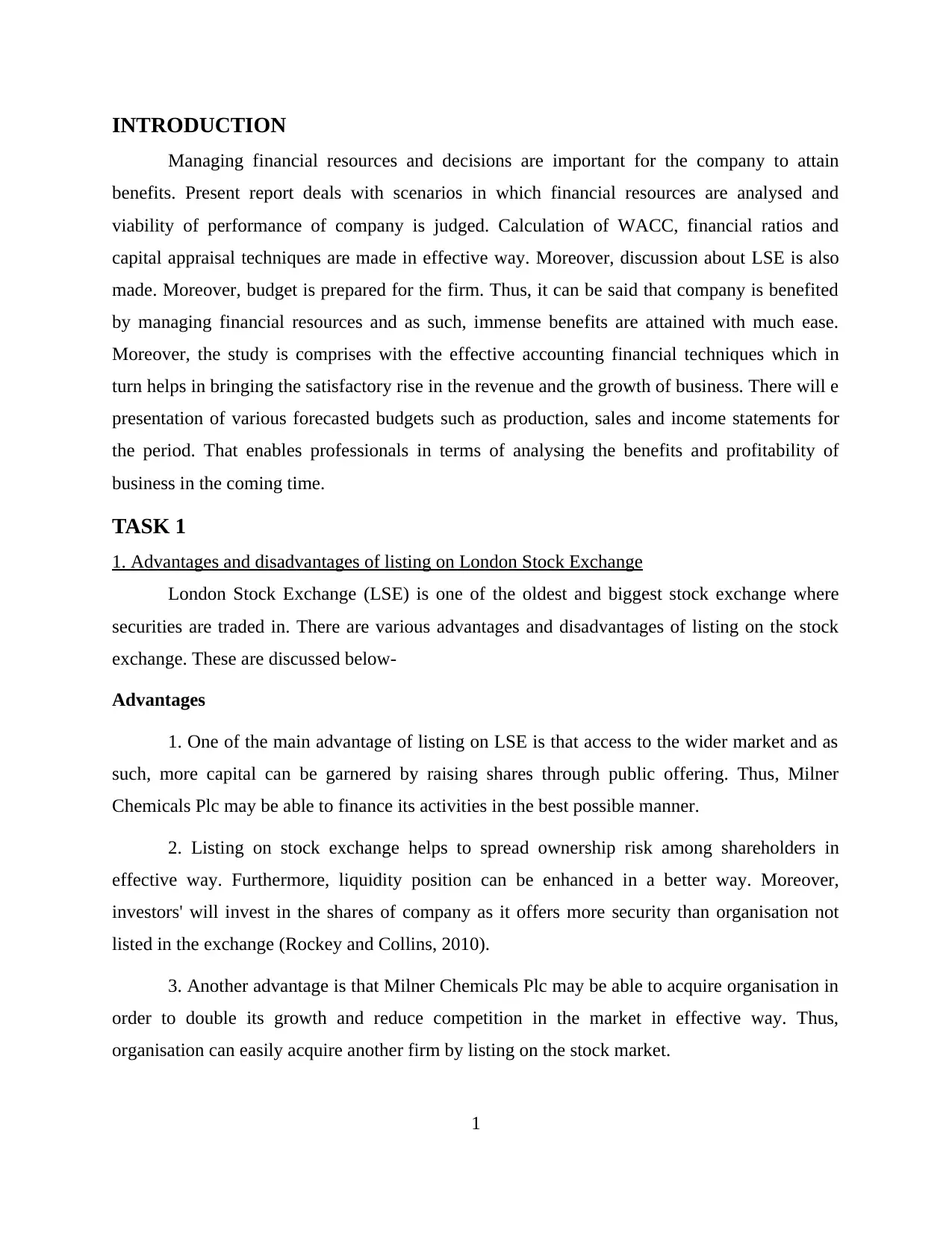
INTRODUCTION
Managing financial resources and decisions are important for the company to attain
benefits. Present report deals with scenarios in which financial resources are analysed and
viability of performance of company is judged. Calculation of WACC, financial ratios and
capital appraisal techniques are made in effective way. Moreover, discussion about LSE is also
made. Moreover, budget is prepared for the firm. Thus, it can be said that company is benefited
by managing financial resources and as such, immense benefits are attained with much ease.
Moreover, the study is comprises with the effective accounting financial techniques which in
turn helps in bringing the satisfactory rise in the revenue and the growth of business. There will e
presentation of various forecasted budgets such as production, sales and income statements for
the period. That enables professionals in terms of analysing the benefits and profitability of
business in the coming time.
TASK 1
1. Advantages and disadvantages of listing on London Stock Exchange
London Stock Exchange (LSE) is one of the oldest and biggest stock exchange where
securities are traded in. There are various advantages and disadvantages of listing on the stock
exchange. These are discussed below-
Advantages
1. One of the main advantage of listing on LSE is that access to the wider market and as
such, more capital can be garnered by raising shares through public offering. Thus, Milner
Chemicals Plc may be able to finance its activities in the best possible manner.
2. Listing on stock exchange helps to spread ownership risk among shareholders in
effective way. Furthermore, liquidity position can be enhanced in a better way. Moreover,
investors' will invest in the shares of company as it offers more security than organisation not
listed in the exchange (Rockey and Collins, 2010).
3. Another advantage is that Milner Chemicals Plc may be able to acquire organisation in
order to double its growth and reduce competition in the market in effective way. Thus,
organisation can easily acquire another firm by listing on the stock market.
1
Managing financial resources and decisions are important for the company to attain
benefits. Present report deals with scenarios in which financial resources are analysed and
viability of performance of company is judged. Calculation of WACC, financial ratios and
capital appraisal techniques are made in effective way. Moreover, discussion about LSE is also
made. Moreover, budget is prepared for the firm. Thus, it can be said that company is benefited
by managing financial resources and as such, immense benefits are attained with much ease.
Moreover, the study is comprises with the effective accounting financial techniques which in
turn helps in bringing the satisfactory rise in the revenue and the growth of business. There will e
presentation of various forecasted budgets such as production, sales and income statements for
the period. That enables professionals in terms of analysing the benefits and profitability of
business in the coming time.
TASK 1
1. Advantages and disadvantages of listing on London Stock Exchange
London Stock Exchange (LSE) is one of the oldest and biggest stock exchange where
securities are traded in. There are various advantages and disadvantages of listing on the stock
exchange. These are discussed below-
Advantages
1. One of the main advantage of listing on LSE is that access to the wider market and as
such, more capital can be garnered by raising shares through public offering. Thus, Milner
Chemicals Plc may be able to finance its activities in the best possible manner.
2. Listing on stock exchange helps to spread ownership risk among shareholders in
effective way. Furthermore, liquidity position can be enhanced in a better way. Moreover,
investors' will invest in the shares of company as it offers more security than organisation not
listed in the exchange (Rockey and Collins, 2010).
3. Another advantage is that Milner Chemicals Plc may be able to acquire organisation in
order to double its growth and reduce competition in the market in effective way. Thus,
organisation can easily acquire another firm by listing on the stock market.
1
Paraphrase This Document
Need a fresh take? Get an instant paraphrase of this document with our AI Paraphraser
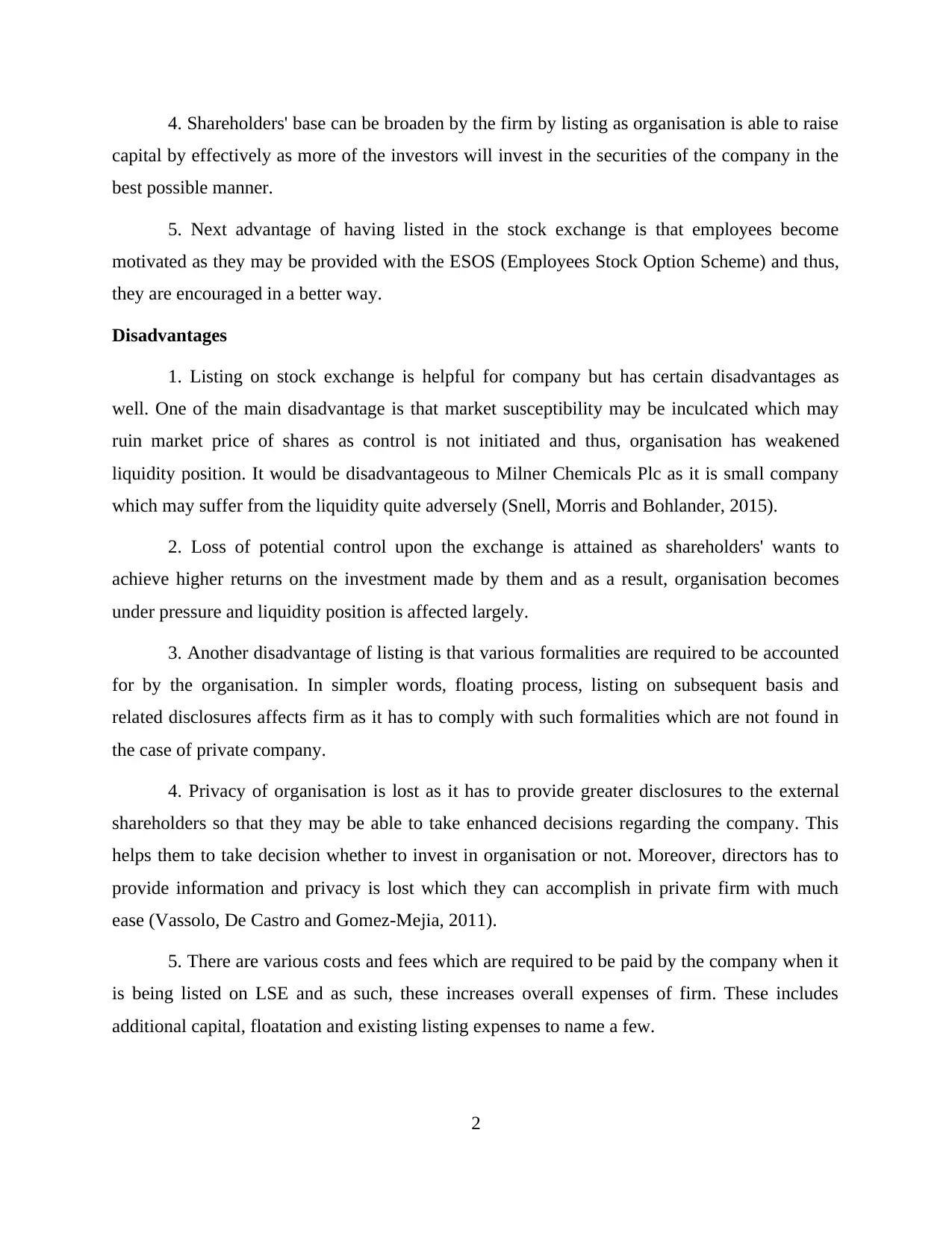
4. Shareholders' base can be broaden by the firm by listing as organisation is able to raise
capital by effectively as more of the investors will invest in the securities of the company in the
best possible manner.
5. Next advantage of having listed in the stock exchange is that employees become
motivated as they may be provided with the ESOS (Employees Stock Option Scheme) and thus,
they are encouraged in a better way.
Disadvantages
1. Listing on stock exchange is helpful for company but has certain disadvantages as
well. One of the main disadvantage is that market susceptibility may be inculcated which may
ruin market price of shares as control is not initiated and thus, organisation has weakened
liquidity position. It would be disadvantageous to Milner Chemicals Plc as it is small company
which may suffer from the liquidity quite adversely (Snell, Morris and Bohlander, 2015).
2. Loss of potential control upon the exchange is attained as shareholders' wants to
achieve higher returns on the investment made by them and as a result, organisation becomes
under pressure and liquidity position is affected largely.
3. Another disadvantage of listing is that various formalities are required to be accounted
for by the organisation. In simpler words, floating process, listing on subsequent basis and
related disclosures affects firm as it has to comply with such formalities which are not found in
the case of private company.
4. Privacy of organisation is lost as it has to provide greater disclosures to the external
shareholders so that they may be able to take enhanced decisions regarding the company. This
helps them to take decision whether to invest in organisation or not. Moreover, directors has to
provide information and privacy is lost which they can accomplish in private firm with much
ease (Vassolo, De Castro and Gomez-Mejia, 2011).
5. There are various costs and fees which are required to be paid by the company when it
is being listed on LSE and as such, these increases overall expenses of firm. These includes
additional capital, floatation and existing listing expenses to name a few.
2
capital by effectively as more of the investors will invest in the securities of the company in the
best possible manner.
5. Next advantage of having listed in the stock exchange is that employees become
motivated as they may be provided with the ESOS (Employees Stock Option Scheme) and thus,
they are encouraged in a better way.
Disadvantages
1. Listing on stock exchange is helpful for company but has certain disadvantages as
well. One of the main disadvantage is that market susceptibility may be inculcated which may
ruin market price of shares as control is not initiated and thus, organisation has weakened
liquidity position. It would be disadvantageous to Milner Chemicals Plc as it is small company
which may suffer from the liquidity quite adversely (Snell, Morris and Bohlander, 2015).
2. Loss of potential control upon the exchange is attained as shareholders' wants to
achieve higher returns on the investment made by them and as a result, organisation becomes
under pressure and liquidity position is affected largely.
3. Another disadvantage of listing is that various formalities are required to be accounted
for by the organisation. In simpler words, floating process, listing on subsequent basis and
related disclosures affects firm as it has to comply with such formalities which are not found in
the case of private company.
4. Privacy of organisation is lost as it has to provide greater disclosures to the external
shareholders so that they may be able to take enhanced decisions regarding the company. This
helps them to take decision whether to invest in organisation or not. Moreover, directors has to
provide information and privacy is lost which they can accomplish in private firm with much
ease (Vassolo, De Castro and Gomez-Mejia, 2011).
5. There are various costs and fees which are required to be paid by the company when it
is being listed on LSE and as such, these increases overall expenses of firm. These includes
additional capital, floatation and existing listing expenses to name a few.
2
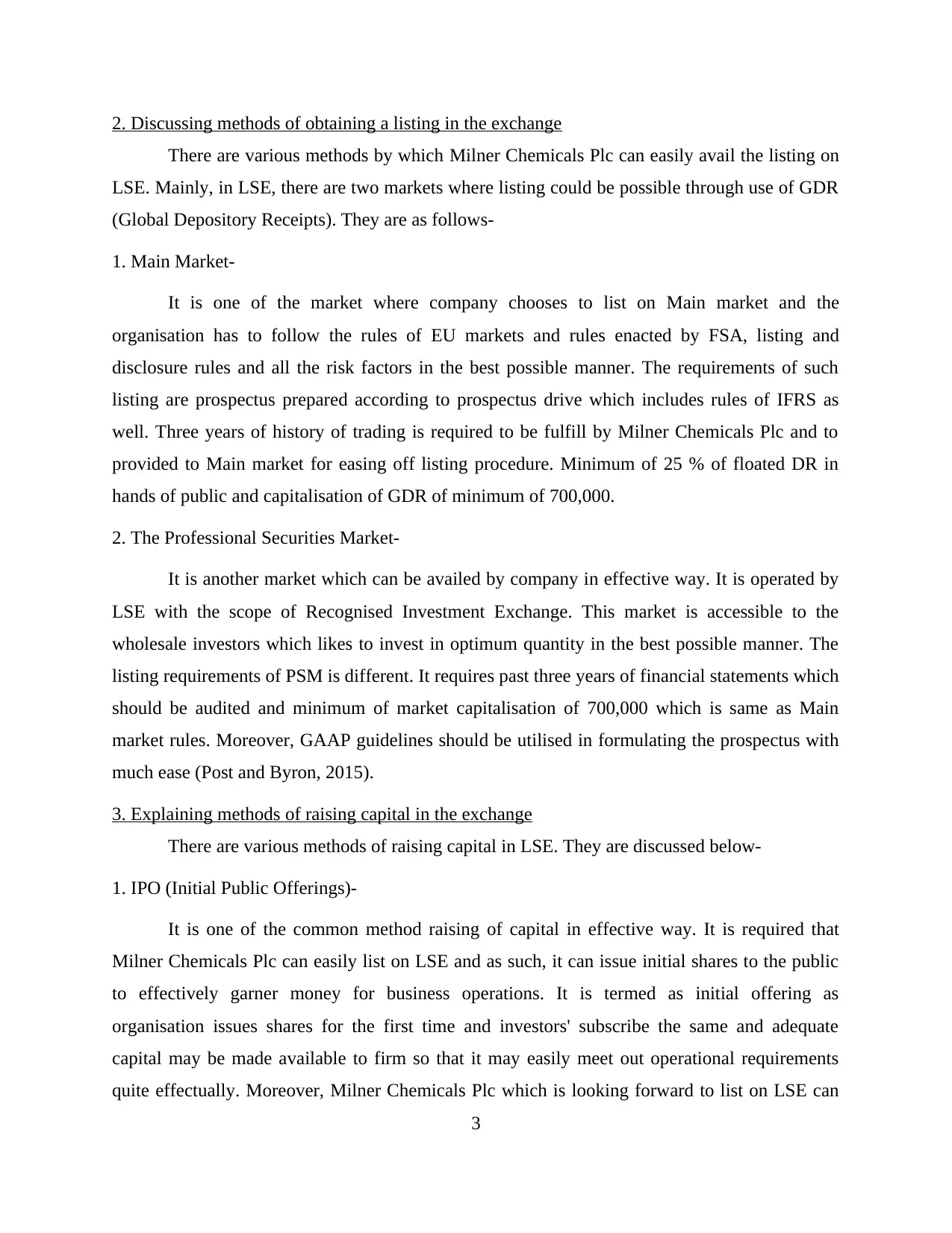
2. Discussing methods of obtaining a listing in the exchange
There are various methods by which Milner Chemicals Plc can easily avail the listing on
LSE. Mainly, in LSE, there are two markets where listing could be possible through use of GDR
(Global Depository Receipts). They are as follows-
1. Main Market-
It is one of the market where company chooses to list on Main market and the
organisation has to follow the rules of EU markets and rules enacted by FSA, listing and
disclosure rules and all the risk factors in the best possible manner. The requirements of such
listing are prospectus prepared according to prospectus drive which includes rules of IFRS as
well. Three years of history of trading is required to be fulfill by Milner Chemicals Plc and to
provided to Main market for easing off listing procedure. Minimum of 25 % of floated DR in
hands of public and capitalisation of GDR of minimum of 700,000.
2. The Professional Securities Market-
It is another market which can be availed by company in effective way. It is operated by
LSE with the scope of Recognised Investment Exchange. This market is accessible to the
wholesale investors which likes to invest in optimum quantity in the best possible manner. The
listing requirements of PSM is different. It requires past three years of financial statements which
should be audited and minimum of market capitalisation of 700,000 which is same as Main
market rules. Moreover, GAAP guidelines should be utilised in formulating the prospectus with
much ease (Post and Byron, 2015).
3. Explaining methods of raising capital in the exchange
There are various methods of raising capital in LSE. They are discussed below-
1. IPO (Initial Public Offerings)-
It is one of the common method raising of capital in effective way. It is required that
Milner Chemicals Plc can easily list on LSE and as such, it can issue initial shares to the public
to effectively garner money for business operations. It is termed as initial offering as
organisation issues shares for the first time and investors' subscribe the same and adequate
capital may be made available to firm so that it may easily meet out operational requirements
quite effectually. Moreover, Milner Chemicals Plc which is looking forward to list on LSE can
3
There are various methods by which Milner Chemicals Plc can easily avail the listing on
LSE. Mainly, in LSE, there are two markets where listing could be possible through use of GDR
(Global Depository Receipts). They are as follows-
1. Main Market-
It is one of the market where company chooses to list on Main market and the
organisation has to follow the rules of EU markets and rules enacted by FSA, listing and
disclosure rules and all the risk factors in the best possible manner. The requirements of such
listing are prospectus prepared according to prospectus drive which includes rules of IFRS as
well. Three years of history of trading is required to be fulfill by Milner Chemicals Plc and to
provided to Main market for easing off listing procedure. Minimum of 25 % of floated DR in
hands of public and capitalisation of GDR of minimum of 700,000.
2. The Professional Securities Market-
It is another market which can be availed by company in effective way. It is operated by
LSE with the scope of Recognised Investment Exchange. This market is accessible to the
wholesale investors which likes to invest in optimum quantity in the best possible manner. The
listing requirements of PSM is different. It requires past three years of financial statements which
should be audited and minimum of market capitalisation of 700,000 which is same as Main
market rules. Moreover, GAAP guidelines should be utilised in formulating the prospectus with
much ease (Post and Byron, 2015).
3. Explaining methods of raising capital in the exchange
There are various methods of raising capital in LSE. They are discussed below-
1. IPO (Initial Public Offerings)-
It is one of the common method raising of capital in effective way. It is required that
Milner Chemicals Plc can easily list on LSE and as such, it can issue initial shares to the public
to effectively garner money for business operations. It is termed as initial offering as
organisation issues shares for the first time and investors' subscribe the same and adequate
capital may be made available to firm so that it may easily meet out operational requirements
quite effectually. Moreover, Milner Chemicals Plc which is looking forward to list on LSE can
3
⊘ This is a preview!⊘
Do you want full access?
Subscribe today to unlock all pages.

Trusted by 1+ million students worldwide
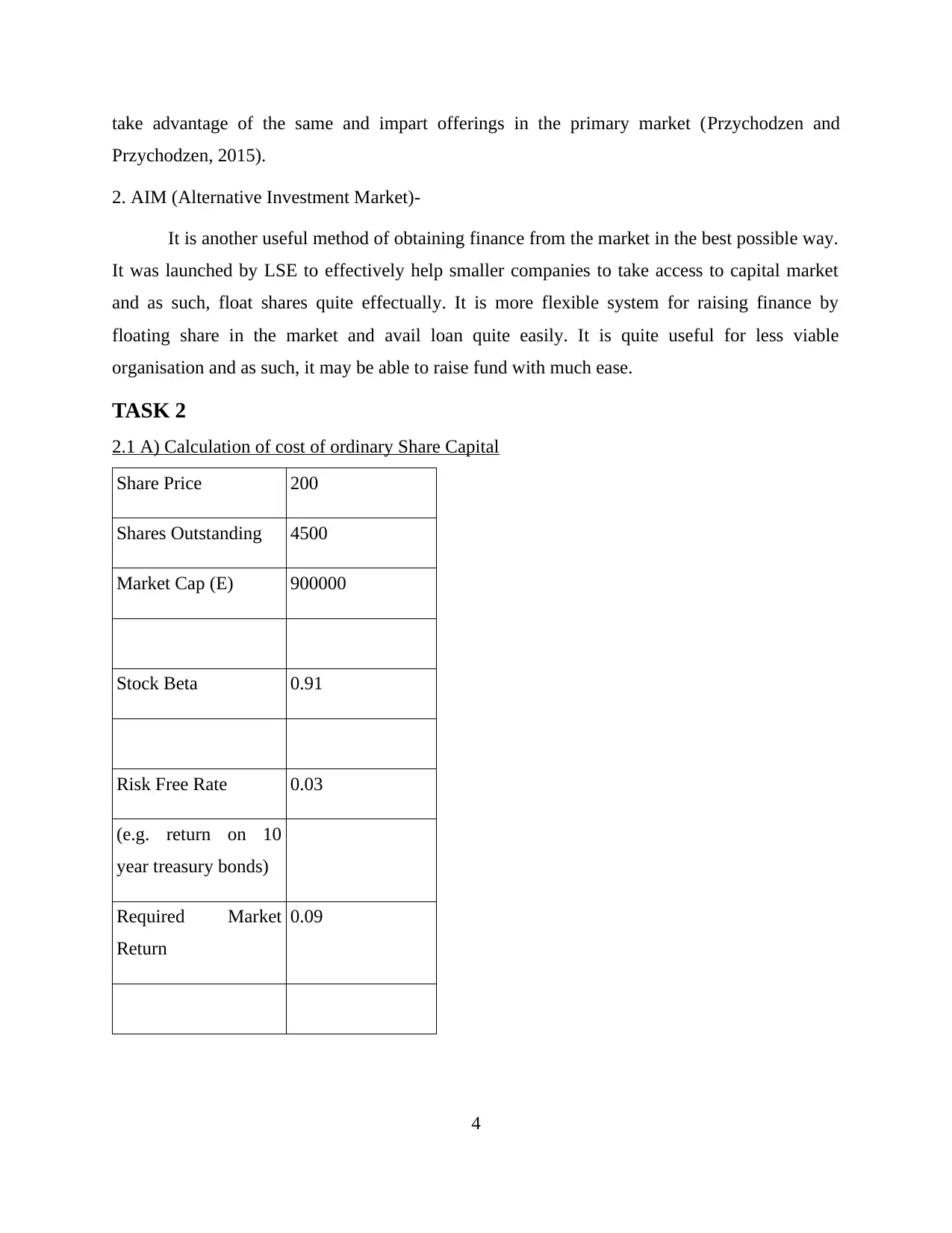
take advantage of the same and impart offerings in the primary market (Przychodzen and
Przychodzen, 2015).
2. AIM (Alternative Investment Market)-
It is another useful method of obtaining finance from the market in the best possible way.
It was launched by LSE to effectively help smaller companies to take access to capital market
and as such, float shares quite effectually. It is more flexible system for raising finance by
floating share in the market and avail loan quite easily. It is quite useful for less viable
organisation and as such, it may be able to raise fund with much ease.
TASK 2
2.1 A) Calculation of cost of ordinary Share Capital
Share Price 200
Shares Outstanding 4500
Market Cap (E) 900000
Stock Beta 0.91
Risk Free Rate 0.03
(e.g. return on 10
year treasury bonds)
Required Market
Return
0.09
4
Przychodzen, 2015).
2. AIM (Alternative Investment Market)-
It is another useful method of obtaining finance from the market in the best possible way.
It was launched by LSE to effectively help smaller companies to take access to capital market
and as such, float shares quite effectually. It is more flexible system for raising finance by
floating share in the market and avail loan quite easily. It is quite useful for less viable
organisation and as such, it may be able to raise fund with much ease.
TASK 2
2.1 A) Calculation of cost of ordinary Share Capital
Share Price 200
Shares Outstanding 4500
Market Cap (E) 900000
Stock Beta 0.91
Risk Free Rate 0.03
(e.g. return on 10
year treasury bonds)
Required Market
Return
0.09
4
Paraphrase This Document
Need a fresh take? Get an instant paraphrase of this document with our AI Paraphraser
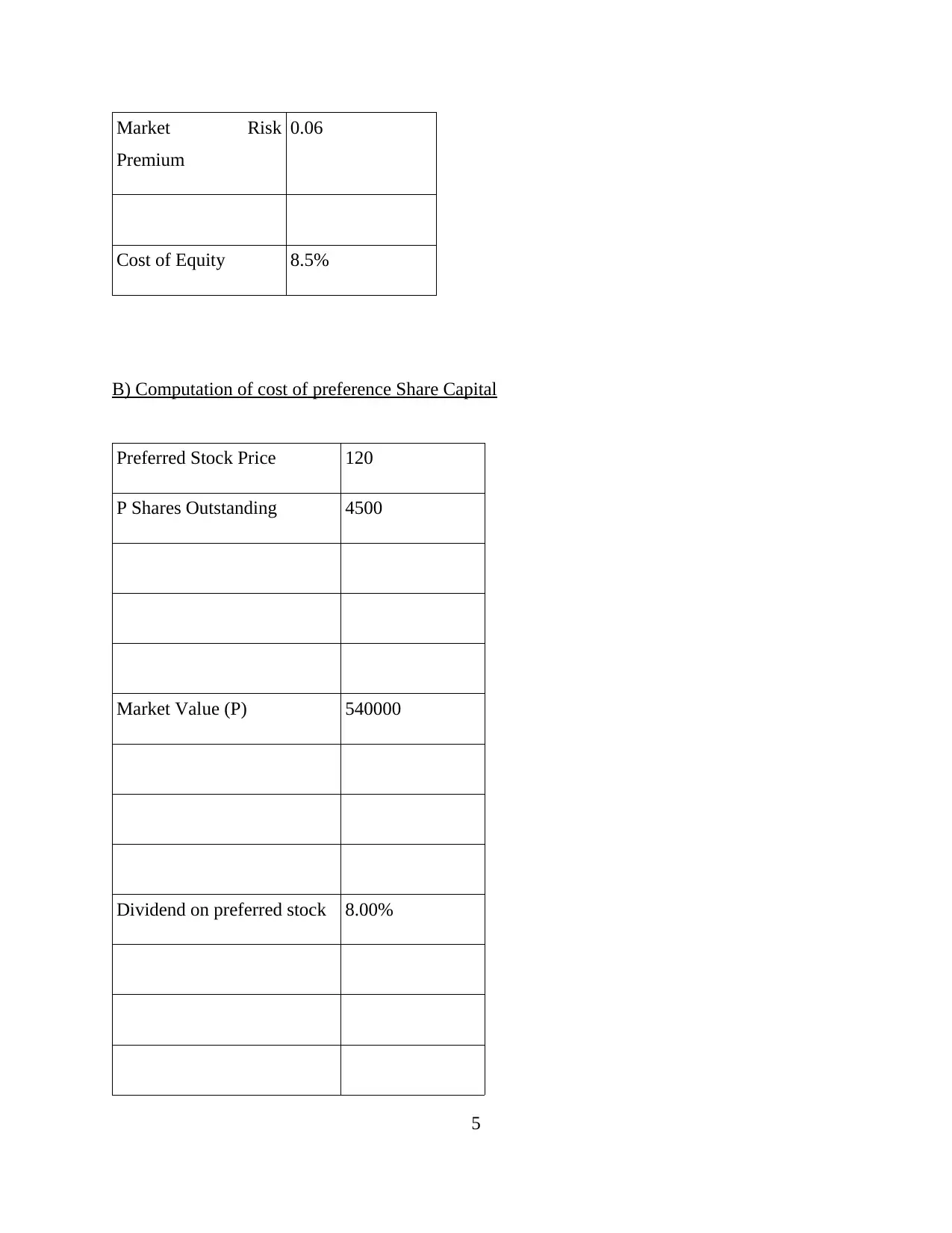
Market Risk
Premium
0.06
Cost of Equity 8.5%
B) Computation of cost of preference Share Capital
Preferred Stock Price 120
P Shares Outstanding 4500
Market Value (P) 540000
Dividend on preferred stock 8.00%
5
Premium
0.06
Cost of Equity 8.5%
B) Computation of cost of preference Share Capital
Preferred Stock Price 120
P Shares Outstanding 4500
Market Value (P) 540000
Dividend on preferred stock 8.00%
5
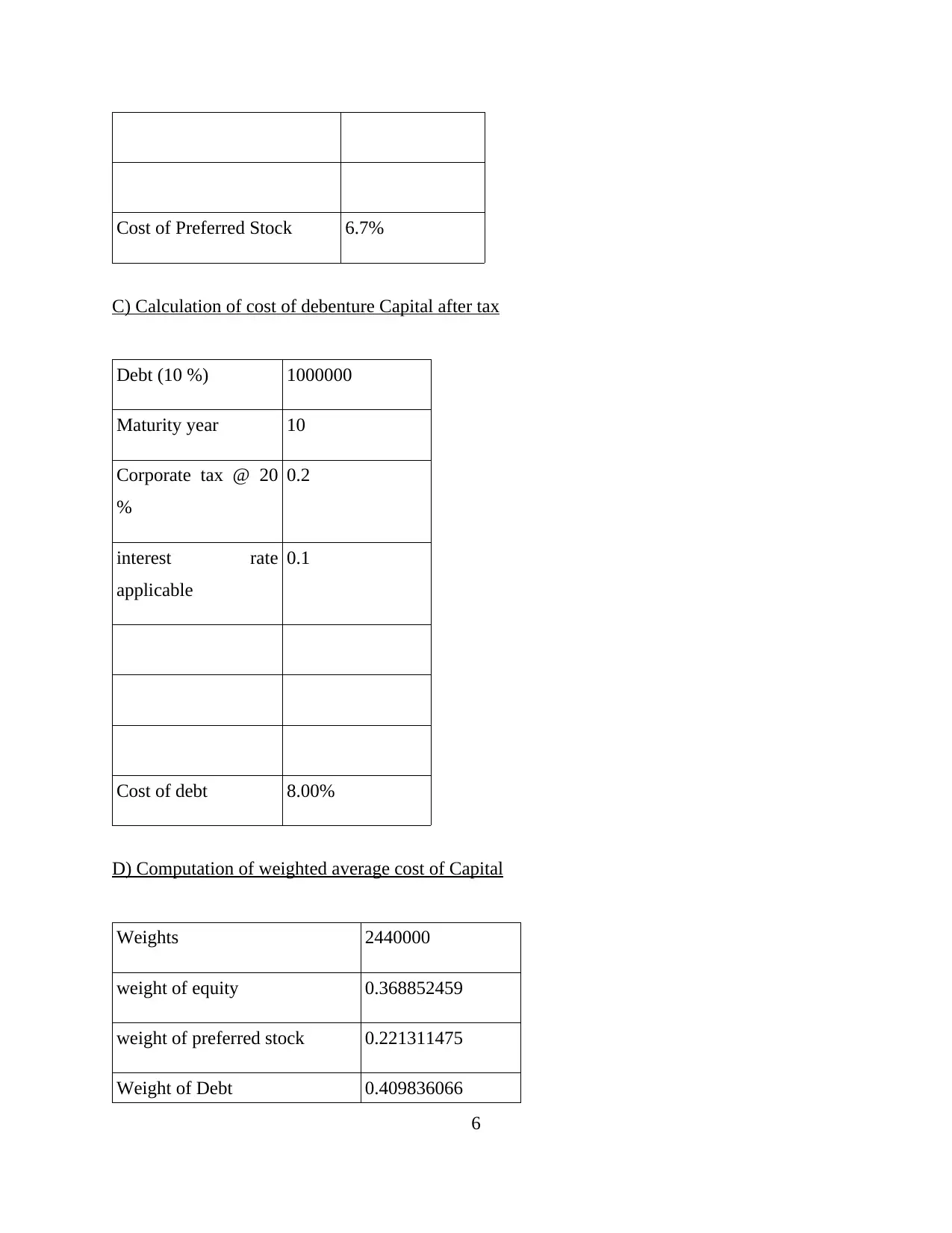
Cost of Preferred Stock 6.7%
C) Calculation of cost of debenture Capital after tax
Debt (10 %) 1000000
Maturity year 10
Corporate tax @ 20
%
0.2
interest rate
applicable
0.1
Cost of debt 8.00%
D) Computation of weighted average cost of Capital
Weights 2440000
weight of equity 0.368852459
weight of preferred stock 0.221311475
Weight of Debt 0.409836066
6
C) Calculation of cost of debenture Capital after tax
Debt (10 %) 1000000
Maturity year 10
Corporate tax @ 20
%
0.2
interest rate
applicable
0.1
Cost of debt 8.00%
D) Computation of weighted average cost of Capital
Weights 2440000
weight of equity 0.368852459
weight of preferred stock 0.221311475
Weight of Debt 0.409836066
6
⊘ This is a preview!⊘
Do you want full access?
Subscribe today to unlock all pages.

Trusted by 1+ million students worldwide
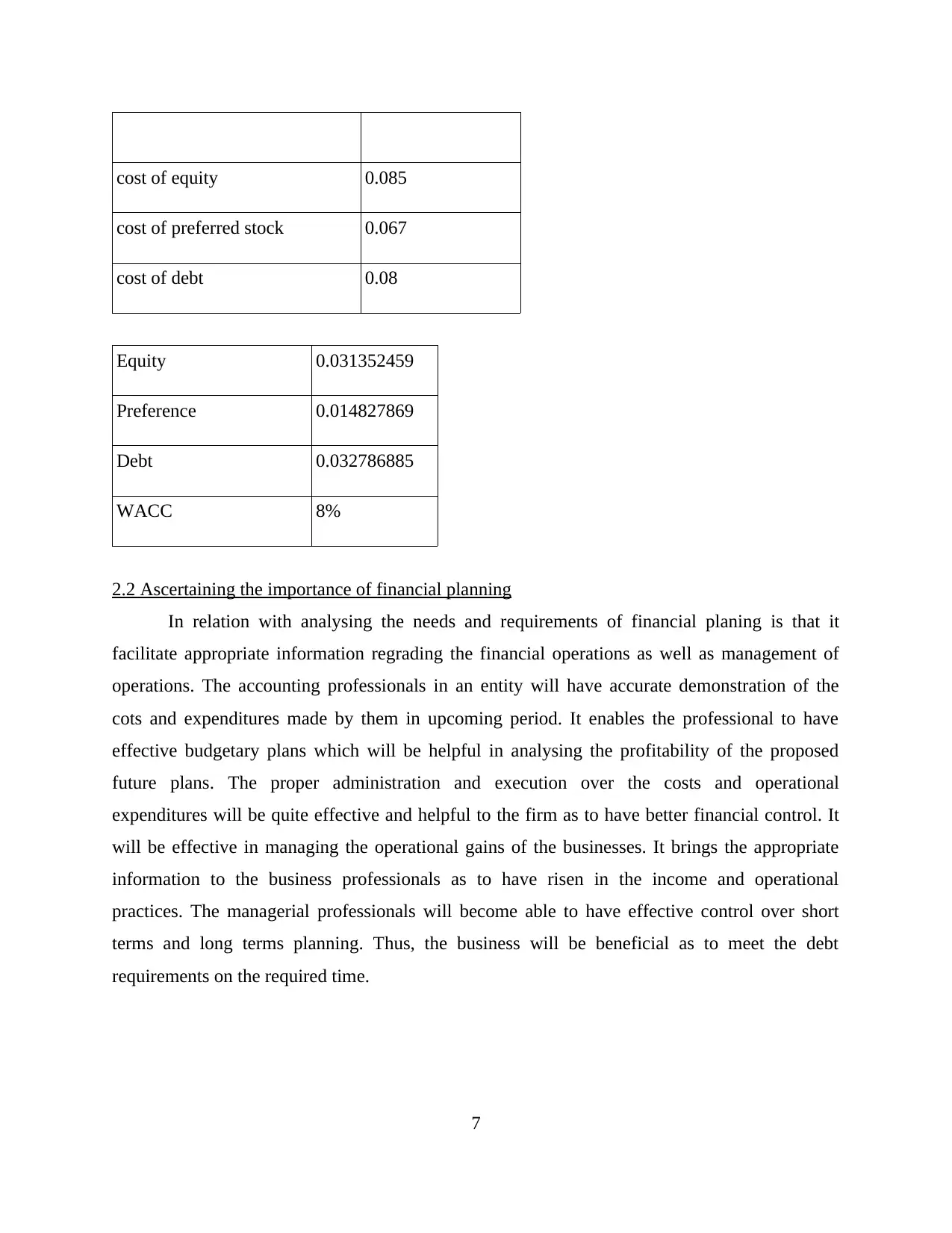
cost of equity 0.085
cost of preferred stock 0.067
cost of debt 0.08
Equity 0.031352459
Preference 0.014827869
Debt 0.032786885
WACC 8%
2.2 Ascertaining the importance of financial planning
In relation with analysing the needs and requirements of financial planing is that it
facilitate appropriate information regrading the financial operations as well as management of
operations. The accounting professionals in an entity will have accurate demonstration of the
cots and expenditures made by them in upcoming period. It enables the professional to have
effective budgetary plans which will be helpful in analysing the profitability of the proposed
future plans. The proper administration and execution over the costs and operational
expenditures will be quite effective and helpful to the firm as to have better financial control. It
will be effective in managing the operational gains of the businesses. It brings the appropriate
information to the business professionals as to have risen in the income and operational
practices. The managerial professionals will become able to have effective control over short
terms and long terms planning. Thus, the business will be beneficial as to meet the debt
requirements on the required time.
7
cost of preferred stock 0.067
cost of debt 0.08
Equity 0.031352459
Preference 0.014827869
Debt 0.032786885
WACC 8%
2.2 Ascertaining the importance of financial planning
In relation with analysing the needs and requirements of financial planing is that it
facilitate appropriate information regrading the financial operations as well as management of
operations. The accounting professionals in an entity will have accurate demonstration of the
cots and expenditures made by them in upcoming period. It enables the professional to have
effective budgetary plans which will be helpful in analysing the profitability of the proposed
future plans. The proper administration and execution over the costs and operational
expenditures will be quite effective and helpful to the firm as to have better financial control. It
will be effective in managing the operational gains of the businesses. It brings the appropriate
information to the business professionals as to have risen in the income and operational
practices. The managerial professionals will become able to have effective control over short
terms and long terms planning. Thus, the business will be beneficial as to meet the debt
requirements on the required time.
7
Paraphrase This Document
Need a fresh take? Get an instant paraphrase of this document with our AI Paraphraser
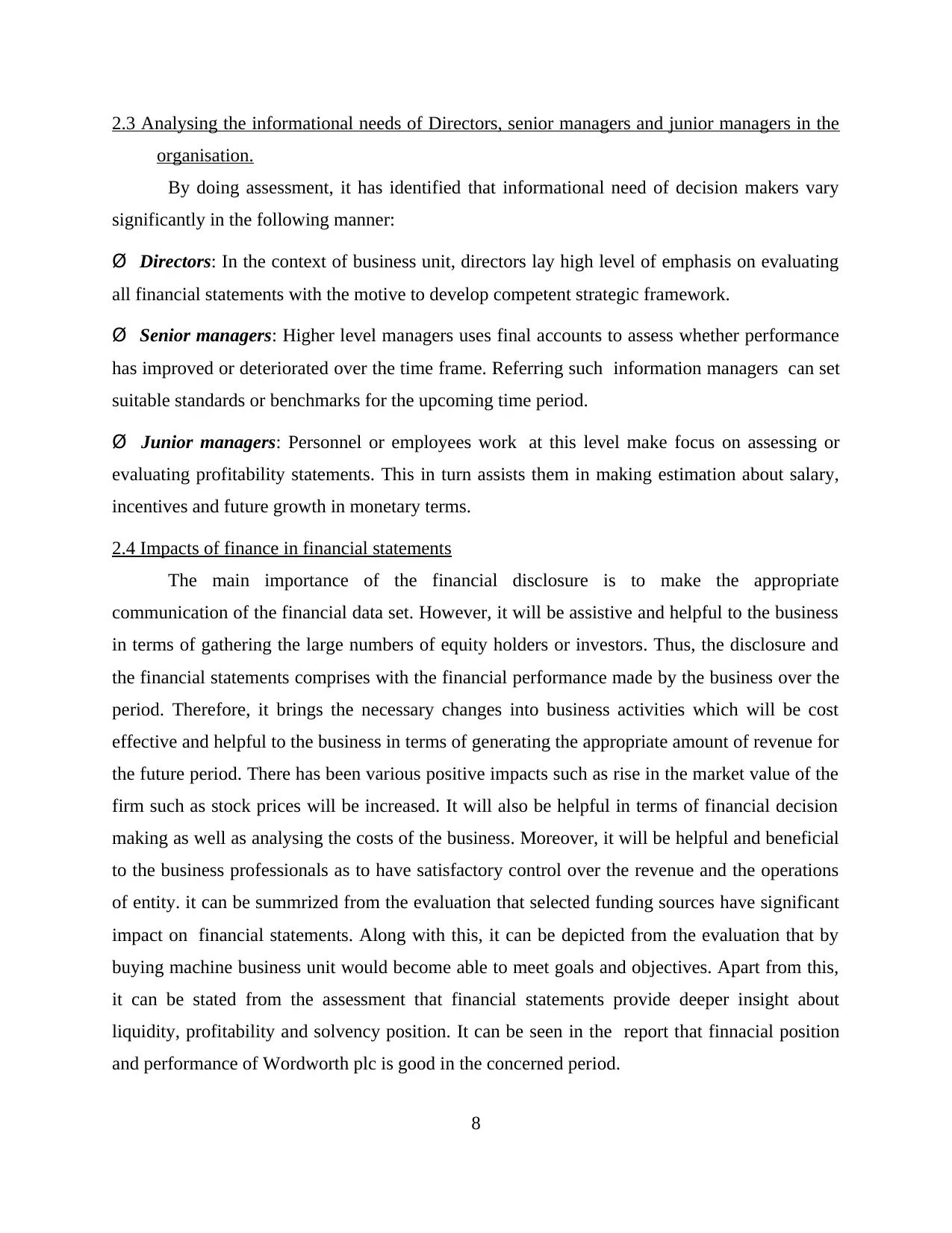
2.3 Analysing the informational needs of Directors, senior managers and junior managers in the
organisation.
By doing assessment, it has identified that informational need of decision makers vary
significantly in the following manner:
Ø Directors: In the context of business unit, directors lay high level of emphasis on evaluating
all financial statements with the motive to develop competent strategic framework.
Ø Senior managers: Higher level managers uses final accounts to assess whether performance
has improved or deteriorated over the time frame. Referring such information managers can set
suitable standards or benchmarks for the upcoming time period.
Ø Junior managers: Personnel or employees work at this level make focus on assessing or
evaluating profitability statements. This in turn assists them in making estimation about salary,
incentives and future growth in monetary terms.
2.4 Impacts of finance in financial statements
The main importance of the financial disclosure is to make the appropriate
communication of the financial data set. However, it will be assistive and helpful to the business
in terms of gathering the large numbers of equity holders or investors. Thus, the disclosure and
the financial statements comprises with the financial performance made by the business over the
period. Therefore, it brings the necessary changes into business activities which will be cost
effective and helpful to the business in terms of generating the appropriate amount of revenue for
the future period. There has been various positive impacts such as rise in the market value of the
firm such as stock prices will be increased. It will also be helpful in terms of financial decision
making as well as analysing the costs of the business. Moreover, it will be helpful and beneficial
to the business professionals as to have satisfactory control over the revenue and the operations
of entity. it can be summrized from the evaluation that selected funding sources have significant
impact on financial statements. Along with this, it can be depicted from the evaluation that by
buying machine business unit would become able to meet goals and objectives. Apart from this,
it can be stated from the assessment that financial statements provide deeper insight about
liquidity, profitability and solvency position. It can be seen in the report that finnacial position
and performance of Wordworth plc is good in the concerned period.
8
organisation.
By doing assessment, it has identified that informational need of decision makers vary
significantly in the following manner:
Ø Directors: In the context of business unit, directors lay high level of emphasis on evaluating
all financial statements with the motive to develop competent strategic framework.
Ø Senior managers: Higher level managers uses final accounts to assess whether performance
has improved or deteriorated over the time frame. Referring such information managers can set
suitable standards or benchmarks for the upcoming time period.
Ø Junior managers: Personnel or employees work at this level make focus on assessing or
evaluating profitability statements. This in turn assists them in making estimation about salary,
incentives and future growth in monetary terms.
2.4 Impacts of finance in financial statements
The main importance of the financial disclosure is to make the appropriate
communication of the financial data set. However, it will be assistive and helpful to the business
in terms of gathering the large numbers of equity holders or investors. Thus, the disclosure and
the financial statements comprises with the financial performance made by the business over the
period. Therefore, it brings the necessary changes into business activities which will be cost
effective and helpful to the business in terms of generating the appropriate amount of revenue for
the future period. There has been various positive impacts such as rise in the market value of the
firm such as stock prices will be increased. It will also be helpful in terms of financial decision
making as well as analysing the costs of the business. Moreover, it will be helpful and beneficial
to the business professionals as to have satisfactory control over the revenue and the operations
of entity. it can be summrized from the evaluation that selected funding sources have significant
impact on financial statements. Along with this, it can be depicted from the evaluation that by
buying machine business unit would become able to meet goals and objectives. Apart from this,
it can be stated from the assessment that financial statements provide deeper insight about
liquidity, profitability and solvency position. It can be seen in the report that finnacial position
and performance of Wordworth plc is good in the concerned period.
8
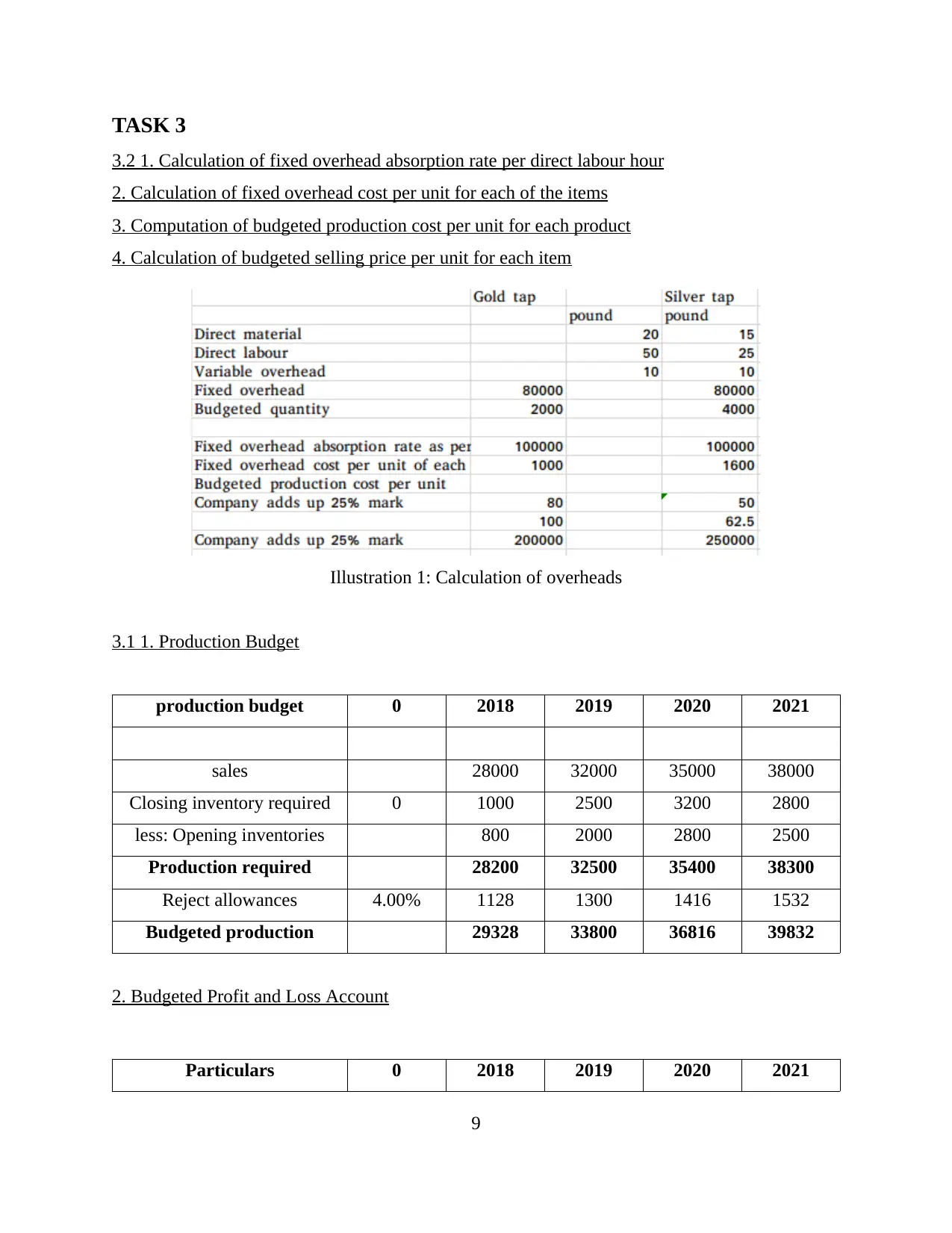
TASK 3
3.2 1. Calculation of fixed overhead absorption rate per direct labour hour
2. Calculation of fixed overhead cost per unit for each of the items
3. Computation of budgeted production cost per unit for each product
4. Calculation of budgeted selling price per unit for each item
3.1 1. Production Budget
production budget 0 2018 2019 2020 2021
sales 28000 32000 35000 38000
Closing inventory required 0 1000 2500 3200 2800
less: Opening inventories 800 2000 2800 2500
Production required 28200 32500 35400 38300
Reject allowances 4.00% 1128 1300 1416 1532
Budgeted production 29328 33800 36816 39832
2. Budgeted Profit and Loss Account
Particulars 0 2018 2019 2020 2021
9
Illustration 1: Calculation of overheads
3.2 1. Calculation of fixed overhead absorption rate per direct labour hour
2. Calculation of fixed overhead cost per unit for each of the items
3. Computation of budgeted production cost per unit for each product
4. Calculation of budgeted selling price per unit for each item
3.1 1. Production Budget
production budget 0 2018 2019 2020 2021
sales 28000 32000 35000 38000
Closing inventory required 0 1000 2500 3200 2800
less: Opening inventories 800 2000 2800 2500
Production required 28200 32500 35400 38300
Reject allowances 4.00% 1128 1300 1416 1532
Budgeted production 29328 33800 36816 39832
2. Budgeted Profit and Loss Account
Particulars 0 2018 2019 2020 2021
9
Illustration 1: Calculation of overheads
⊘ This is a preview!⊘
Do you want full access?
Subscribe today to unlock all pages.

Trusted by 1+ million students worldwide
1 out of 20
Related Documents
Your All-in-One AI-Powered Toolkit for Academic Success.
+13062052269
info@desklib.com
Available 24*7 on WhatsApp / Email
![[object Object]](/_next/static/media/star-bottom.7253800d.svg)
Unlock your academic potential
Copyright © 2020–2025 A2Z Services. All Rights Reserved. Developed and managed by ZUCOL.





